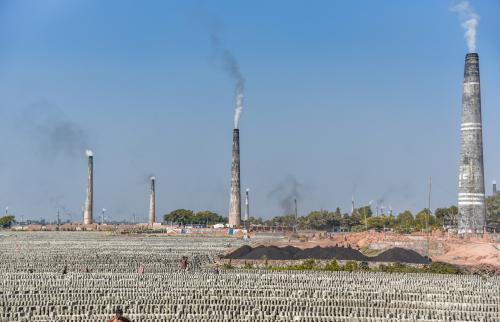On December 4, Congressman Edward Markey of Massachusetts wrote a letter to Energy Secretary Steven Chu questioning the wisdom of exporting large quantities of U.S. natural gas. His concerns were wide-ranging and included the potential price impacts of exports and the residual impact of higher gas prices on electricity generation and manufacturing, the potential for more volatile natural gas prices, and the environmental impact of raising the cost of gas, which he characterized as a “bridge” fuel from coal to renewable energy.
The reality is far more complex. The Energy Security Initiative at Brookings this week released an interim report examining the feasibility of large-scale U.S. natural gas exports. The report shows that there are a range of factors – political, economic, and technical – that will have an impact on the feasibility of natural gas exports. Being an interim report, it has not yet come to any conclusions on the merits of natural gas exports. But that is precisely the point: the issue is too nuanced for a brief analysis. The impacts of exports on domestic gas prices, industry and manufacturing, and gas-price volatility outlined by Congressman Markey and others require more examination.
The charge that exports will result in a spike in prices is likely to be an exaggeration. A report often cited by opponents of natural gas exports, compiled by Navigant Consulting, states that exporting 2 billon cubic feet/day of gas would result in a $0.35 (11 percent) increase in natural gas prices by 2015. However, the model is based on a static supply curve, which means that it does not incorporate increased investment in production as a result of higher natural gas prices, and therefore exaggerates the domestic price response. Navigant itself acknowledges in its report that it views the price outcomes modeled in its analysis as “establishing the upper range of impacts that exports […] might have on natural gas prices.” Other consultancies have published reports on the quantitative impacts of U.S. natural gas exports using dynamic supply curves, in which investment in production increases with higher prices. These found less dramatic increases in natural gas prices. Deloitte, a consultancy, found that by 2035, exporting 6 billion cubic feet/day will result in, on average, a $0.12 (1.7 percent) increase in natural gas prices. ICF International, another consultancy, found that exports of 6 billion cubicfeet/day would result in a $0.64 (11 percent) increase in price by 2035.
Congressman Markey points to the oil market as a cautionary tale, saying that the United States was once a major oil exporter, but now finds itself as the world’s largest importer. This is a misleading comparison: unlike the global oil market, which converges around a single price, the natural gas market is still very segmented, with regional gas prices dependent on a range of factors including pipeline and storage availability, and contract structure. Unlike oil, the export of liquefied natural gas (LNG), is limited by liquefaction capacity, raising the economic and transaction costs of exports and giving domestic customers a buffer against direct competition with international consumers.
It is also important to note that any increase in natural gas prices as a result of exports is likely to vary significantly across the country. As in the international market, domestic natural gas prices vary by location, often due to the proximity to natural gas resources. According to the Deloitte study, New England, which traditionally has some of the highest natural gas prices in the country, will likely see only a minimal increase in response because of its proximity to the Marcellus Shale with its giant reserves of unconventional gas.
The uncertainty surrounding the pricing implications of exports also applies to the potential impact on industrial production. The American Chemistry Council, a trade association that represents many of the U.S.’s largest industrial companies and manufacturers, is inconclusive on the impact of gas exports simply acknowledging that “the economic effects arising from the development of shale gas for … possible exports could be examined.” If price-impact projections of exports noted above are accurate, U.S. industry and manufacturers will likely remain competitive with foreign competitors, many of which depend on higher-cost oil as an industrial feedstock. Moreover, exports of dry gas would have minimal impact on the availability of natural gas liquids, such as ethane, which are the principal components of a number of manufactured goods.
The final argument made by many opponents to natural gas exports contends that exporting natural gas will result in greater volatility in the domestic natural gas market. The merits of this argument are unclear. There has been little quantitative analysis of the issue. In an article last year, Michael Levi, an energy expert at the Council on Foreign Relations, suggested that increased exports could lead to an increase in domestic price volatility. Dr Levi suggested that an international price shock could provide an opportunity for exporters to export natural gas at the expense of domestic consumers; however, this argument ignores the fact that export capacity is, and will likely continue to be, capped. Of the country’s potential total export capacity, only a portion of it will be available for spot market consumption (with the rest being locked into long-term contracts), minimizing the impact on domestic prices. (In fairness to Dr. Levi, he also concluded that the impact on volatility is uncertain.) Opponents of natural gas exports should also consider not only the domestic price but also the price of imported goods from natural gas. If manufacturers in Asia or Europe are paying less for energy and electricity to produce U.S.-bound goods, the benefits accrue to the U.S. consumer.
The debate on the prospect of natural gas exports from the United States will only become louder this year. In addition to Cheniere Energy’s export facility in Louisiana, a number of other companies have received preliminary approval from the Department of Energy to export gas to free-trade agreement countries (Cheniere is currently the only company allowed to export gas to non-free-trade-agreement countries). As the debate continues, the full range of factors needs to be considered; too simplistic an analysis may lead to decisions based on politics rather than economics, and that end up being costly to U.S. consumers in the long-run.



Commentary
Op-edThe Full Story on Natural Gas Exports
January 17, 2012